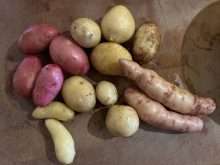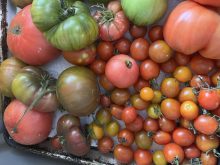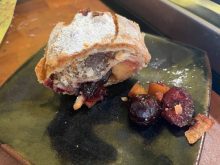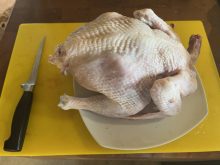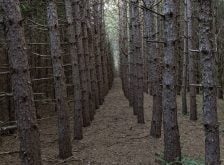Some years ago, I went on a road trip — a research tour for a book I envisioned writing about small-scale organic and sustainable farmers in Western Canada. I drove from my home in Calgary through the mountains into the verdant interior valleys of B.C., then west to the coast, to Vancouver Island and up the Salish Sea to the inside passage’s many green islands. I came home saturated with images and ideas.
That particular book, alas, never came to be. But the trip was eye-opening, and among the most notable of my hosts was Dan Jason of Salt Spring Seeds, a seed-saver’s garden on Salt Spring Island. Dan opened his farm to me without hesitation, as most truly open-hearted gardeners I’ve known are prone to do. After showing me around, Dan went back to his house where he was cleaning seeds, and left me to wander around with my camera to take pictures. It was late summer, tipping into autumn, and his garden beds and fields were like another planet, crops gone way past the recognizable state of being ready to harvest, full into the crazed flush of creating another generation of life, a wildness of extravagant ripeness, with glowing aureoles of seed-fluff and crackling seedpods everywhere I turned.
Regrettably, I lost all the images from that memorable trip. But they linger in my head. Today, as I package tomato seeds I have dried for next year’s garden, I’m mentally wandering that West Coast garden of wonder.
Read Also

Gentle treatments for pain in the neck
Heading toward year-end, people unknowingly tense up against the cold and busyness, causing neck pain that can often be treated with appropriate support and gentle mobility, athletic therapist Kathlyn Hossack says.
READ MORE: Saving your own crop seed
This summer I decided saving seeds was something I’ve avoided for too long. It’s true I love perusing seed catalogues in the winter and my annual mid-March visit to our annual local Seedy Saturday to buy seeds from local seed-growers. It’s a chance to yak about gardening and support plant diversity, an opportunity to quiz those pros on what varieties they prefer for our challenging Prairie climate, and a time for re-imagining my garden.

So I decided I’d do both: I’ll attend Seedy Saturday; and I will save seeds. I started with tomatoes. I’ve had a bumper crop this year, my best ever, and I want to do it again, if I can persuade Mother Nature to make with the spring rain.
There’s a lot of data on how to save seeds, so I settled on two leaders: Dan Jason himself, and his book, Saving Seeds: A Home Gardener’s Guide to Preserving Plant Biodiversity, from Harbour Publishing; and How to Save Your Own Seeds: A Handbook for Small-Scale Seed Production, from Seeds of Diversity Canada.

“Our lives depend on the seed and food choices we make,” Dan writes. “We can stand up for the holiness of the earth and all its wonders.” Those words take me straight back to his garden. His small book is jam-packed with information. Then I turn to the handbook from Seeds of Diversity. Feeling diligent, I remind myself of my status as a novice and begin at the beginning. I’d skipped ahead to the “how-to” pages several days ago, and now have five varieties of tomato seeds successfully drying in labelled ramekins on the kitchen counter. To catch up with myself, I read about pollinators, and about flower structure — complete and incomplete flowers that are open or closed, self-pollinating or cross-pollinating by winds or birds or insects — biology I probably learned in Grade 10 and forgot by Grade 11.

I am waiting for my peas’ and beans’ vines and last pods to dry, until they are brown and crackling like Dan’s. Tackling biennials such as carrots will take a little more planning to dig up and overwinter the roots before I replant them in early spring and harvest their seed crop next summer. I’ll add more types of plants next summer. First we eat, then we save seeds so we can eat next year.

Sourdough, herb and tomato salad
For the season’s last tomato hurrah, use sturdy sourdough bread and the last tomatoes ripening on your counter. When tomato season passes, use a good European jar of of roasted bell peppers or roasted eggplant. Serves 4.
- ½ cup extra virgin olive oil
- 2 Tbsp. mustard (your choice)
- ¼ c. fruit-infused white wine vinegar
- A dash of sherry vinegar
- 1 Tbsp. pomegranate molasses
- 1 lb. ripe tomatoes, medium dice
- ¼ c. red onion, minced
- ½ c. chopped kalamata olives
- 2 Tbsp. fresh basil leaves, torn
- 1 tbsp. fresh mint leaves, torn
- 1 Tbsp, chopped parsley
- 3-4 green onions, thinly sliced
- Kosher salt and freshly cracked black pepper to taste
- 4 cups sourdough bread cut in half-inch cubes
Combine all ingredients except the tomatoes. Mix well and let stand for 15 minutes to develop flavour. Toast the bread cubes under the broiler, then transfer most of them to a salad bowl. Add the dressing. Toss well. If it’s too dry, add a spoonful of cold water and toss again. Garnish with the reserved croutons. Serve immediately.



